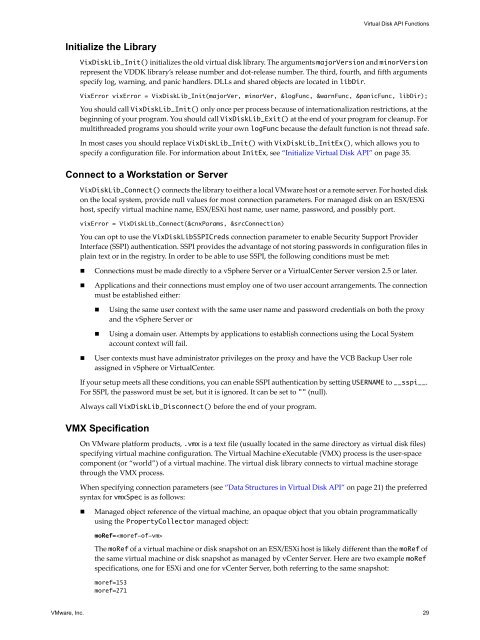Virtual Disk API Programming Guide - Documentation - VMware
Virtual Disk API Programming Guide - Documentation - VMware
Virtual Disk API Programming Guide - Documentation - VMware
You also want an ePaper? Increase the reach of your titles
YUMPU automatically turns print PDFs into web optimized ePapers that Google loves.
Initialize the Library<br />
<strong>Virtual</strong> <strong>Disk</strong> <strong>API</strong> Functions<br />
Vix<strong>Disk</strong>Lib_Init() initializes the old virtual disk library. The arguments majorVersion and minorVersion<br />
represent the VDDK library’s release number and dot‐release number. The third, fourth, and fifth arguments<br />
specify log, warning, and panic handlers. DLLs and shared objects are located in libDir.<br />
VixError vixError = Vix<strong>Disk</strong>Lib_Init(majorVer, minorVer, &logFunc, &warnFunc, &panicFunc, libDir);<br />
You should call Vix<strong>Disk</strong>Lib_Init() only once per process because of internationalization restrictions, at the<br />
beginning of your program. You should call Vix<strong>Disk</strong>Lib_Exit() at the end of your program for cleanup. For<br />
multithreaded programs you should write your own logFunc because the default function is not thread safe.<br />
In most cases you should replace Vix<strong>Disk</strong>Lib_Init() with Vix<strong>Disk</strong>Lib_InitEx(), which allows you to<br />
specify a configuration file. For information about InitEx, see “Initialize <strong>Virtual</strong> <strong>Disk</strong> <strong>API</strong>” on page 35.<br />
Connect to a Workstation or Server<br />
Vix<strong>Disk</strong>Lib_Connect() connects the library to either a local <strong>VMware</strong> host or a remote server. For hosted disk<br />
on the local system, provide null values for most connection parameters. For managed disk on an ESX/ESXi<br />
host, specify virtual machine name, ESX/ESXi host name, user name, password, and possibly port.<br />
vixError = Vix<strong>Disk</strong>Lib_Connect(&cnxParams, &srcConnection)<br />
You can opt to use the Vix<strong>Disk</strong>LibSSPICreds connection parameter to enable Security Support Provider<br />
Interface (SSPI) authentication. SSPI provides the advantage of not storing passwords in configuration files in<br />
plain text or in the registry. In order to be able to use SSPI, the following conditions must be met:<br />
Connections must be made directly to a vSphere Server or a <strong>Virtual</strong>Center Server version 2.5 or later.<br />
Applications and their connections must employ one of two user account arrangements. The connection<br />
must be established either:<br />
Using the same user context with the same user name and password credentials on both the proxy<br />
and the vSphere Server or<br />
Using a domain user. Attempts by applications to establish connections using the Local System<br />
account context will fail.<br />
User contexts must have administrator privileges on the proxy and have the VCB Backup User role<br />
assigned in vSphere or <strong>Virtual</strong>Center.<br />
If your setup meets all these conditions, you can enable SSPI authentication by setting USERNAME to __sspi__.<br />
For SSPI, the password must be set, but it is ignored. It can be set to "" (null).<br />
Always call Vix<strong>Disk</strong>Lib_Disconnect() before the end of your program.<br />
VMX Specification<br />
On <strong>VMware</strong> platform products, .vmx is a text file (usually located in the same directory as virtual disk files)<br />
specifying virtual machine configuration. The <strong>Virtual</strong> Machine eXecutable (VMX) process is the user‐space<br />
component (or “world”) of a virtual machine. The virtual disk library connects to virtual machine storage<br />
through the VMX process.<br />
When specifying connection parameters (see “Data Structures in <strong>Virtual</strong> <strong>Disk</strong> <strong>API</strong>” on page 21) the preferred<br />
syntax for vmxSpec is as follows:<br />
Managed object reference of the virtual machine, an opaque object that you obtain programmatically<br />
using the PropertyCollector managed object:<br />
moRef=<br />
The moRef of a virtual machine or disk snapshot on an ESX/ESXi host is likely different than the moRef of<br />
the same virtual machine or disk snapshot as managed by vCenter Server. Here are two example moRef<br />
specifications, one for ESXi and one for vCenter Server, both referring to the same snapshot:<br />
moref=153<br />
moref=271<br />
<strong>VMware</strong>, Inc. 29

















